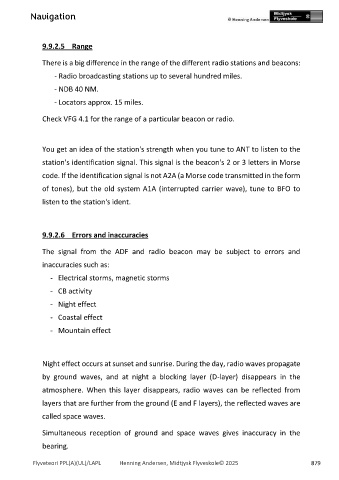Page 879 - PPL-engelsk 2025
P. 879
Navigation
9.9.2.5 Range
There is a big difference in the range of the different radio stations and beacons:
- Radio broadcasting stations up to several hundred miles.
- NDB 40 NM.
- Locators approx. 15 miles.
Check VFG 4.1 for the range of a particular beacon or radio.
You get an idea of the station's strength when you tune to ANT to listen to the
station's identification signal. This signal is the beacon's 2 or 3 letters in Morse
code. If the identification signal is not A2A (a Morse code transmitted in the form
of tones), but the old system A1A (interrupted carrier wave), tune to BFO to
listen to the station's ident.
9.9.2.6 Errors and inaccuracies
The signal from the ADF and radio beacon may be subject to errors and
inaccuracies such as:
- Electrical storms, magnetic storms
- CB activity
- Night effect
- Coastal effect
- Mountain effect
Night effect occurs at sunset and sunrise. During the day, radio waves propagate
by ground waves, and at night a blocking layer (D-layer) disappears in the
atmosphere. When this layer disappears, radio waves can be reflected from
layers that are further from the ground (E and F layers), the reflected waves are
called space waves.
Simultaneous reception of ground and space waves gives inaccuracy in the
bearing.
Flyveteori PPL(A)(UL)/LAPL Henning Andersen, Midtjysk Flyveskole© 2025 879

